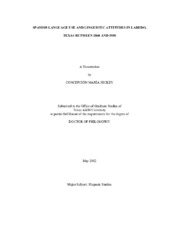| dc.description.abstract | This qualitative study investigated Spanish language use and linguistic attitudes in Laredo, Texas and the surrounding area from 1860 to 1930. In the public domain, sources include the Spanish and English language newspapers and Webb County Court documents. These were analyzed for evidence of the impact of English language contact and prevailing attitudes towards the use of Spanish from both the Hispanic and Anglo perspective. In the private domain, three major collections of private correspondence as well as other miscellaneous correspondence and records were transcribed and analyzed for evidence of metalinguistic or other attitudes towards Spanish. A linguistic analysis of the orthographic, phonological, morphosyntactic, and pragmatic features of Spanish used in the correspondence was also conducted. The major collections of correspondence and other private papers include: 1) the John Z. Leyendecker collection, 2) letters from the Clemente and Federico Idar Family Papers, and 3) the Miguel San Miguel Jr. private collection. The multiple authors in these collections come from low to middle income families and from varied educational and linguistic backgrounds, thus providing a broad socio-economic linguistic sample. Findings include a strong support for Spanish language use and teaching/learning of the Spanish language as well as varied levels of language confidence among bilingual and aspiring second language learners. Negative attitudes regarding class and lack of education rather than ethnicity were clearly held by some writers. Additionally, mixed attitudes about the strong presence of the Mexican culture in Laredo were found. The linguistic analysis found little evidence of English impact during the 1860s, but growing evidence of its influence during the early 20th century. Most prevalent were the use of English loan words, nativized loan words, and nonce borrowings. Some evidence of language shift was noted in the younger writers of the twentieth century. A few of the more salient Spanish linguistic features found include the use of the synthetic future verb form, minimal confusion between ser and estar, metathesis, apocope, vowel raising and lowering, and archaic expressions. | en |



